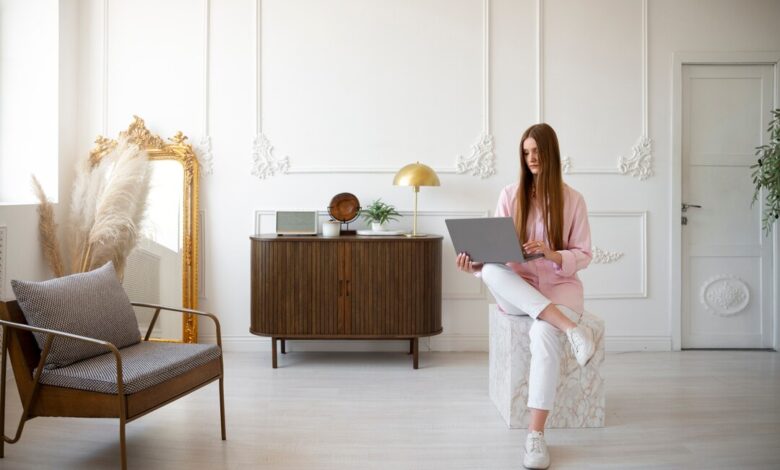The Allure of Luxury Interiors: Crafting Spaces of Elegance and Comfort
In the world of design, luxury interiors are the epitome of sophistication and grandeur. These spaces are not merely rooms; they are a testament to the finest craftsmanship, innovative design, and a deep understanding of aesthetics. Whether in a sprawling mansion, a high-end apartment, or an exclusive boutique hotel, luxury interiors create an ambiance that captivates and inspires. This article delves into the defining features, key elements, and trends in luxury interior design, offering a glimpse into the art of creating spaces that exude opulence and comfort.
Defining Luxury Interiors
Luxury interiors are characterized by their exclusivity, attention to detail, and the use of premium materials. These spaces go beyond functionality; they are designed to evoke emotions and elevate the living experience. Luxury is not just about expense but about the thoughtful integration of elements that make a space unique and personal.
Key features of luxury interiors include:
- High-Quality Materials: From marble countertops to hardwood floors, the use of premium materials is a hallmark of luxury interiors. These materials not only enhance the visual appeal but also ensure durability and timelessness.
- Bespoke Furniture and Decor: Custom-made pieces add a touch of individuality, making each space one-of-a-kind. Handcrafted furniture, tailored upholstery, and unique art pieces contribute to the overall aesthetic.
- Innovative Design: Luxury interiors often incorporate cutting-edge technology and creative design solutions to optimize space and functionality. Smart home systems, hidden storage, and modular furniture are common features.
- Attention to Detail: Every element, from lighting fixtures to door handles, is meticulously chosen to complement the overall theme. This level of detail ensures a cohesive and harmonious design.
- Personalization: A luxury interior reflects the personality and preferences of its owner. Designers often work closely with clients to understand their tastes and incorporate personal touches into the design.
Key Elements of Luxury Interior Design
Creating a luxury interior involves a careful selection and arrangement of elements that contribute to its grandeur. Here are some key aspects that define luxury interiors:
1. Lighting
Lighting plays a pivotal role in setting the mood and highlighting the design features of a space. In luxury interiors, lighting is often layered to create depth and ambiance. Chandeliers, pendant lights, and sconces made of crystal, brass, or other premium materials are popular choices. Smart lighting systems that allow customization of brightness and color temperature add an extra layer of sophistication.
2. Color Palette
Neutral tones like beige, cream, and gray are often used as a base, complemented by bold accents such as deep blues, emerald greens, or golds. The choice of colors should evoke a sense of calm and elegance while providing opportunities for striking contrasts.
3. Textures and Patterns
The interplay of textures and patterns adds depth and interest to luxury interiors. Velvet, silk, and leather are commonly used for upholstery, while wallpapers and carpets often feature intricate patterns or subtle metallic finishes. Combining different textures, like a plush rug with a sleek glass coffee table, creates a balanced and inviting atmosphere.
4. Space Planning
Efficient space planning is crucial in luxury interiors. Open layouts with clearly defined zones for different activities are preferred. Furniture placement, traffic flow, and the balance of empty and filled spaces are carefully considered to ensure functionality and comfort.
5. Art and Accessories
Artworks and accessories serve as the finishing touches that tie a room together. Statement pieces, such as sculptures, paintings, or large mirrors, act as focal points. Accessories like designer vases, scented candles, and curated book collections add personality and charm.
Trends in Luxury Interior Design
The world of luxury interiors is ever-evolving, with new trends shaping the way we perceive and design these spaces. Some of the current trends include:
1. Sustainability
Eco-friendly materials and sustainable design practices are becoming increasingly popular in luxury interiors. Reclaimed wood, recycled metal, and organic fabrics are used to create spaces that are both luxurious and environmentally conscious.
2. Biophilic Design
The incorporation of natural elements, such as indoor plants, water features, and large windows that maximize natural light, is a growing trend. Biophilic design enhances well-being and creates a connection with nature.
3. Technology Integration
Smart home technologies, including automated lighting, climate control, and entertainment systems, are integral to modern luxury interiors. Voice-activated devices and app-controlled features provide convenience and a futuristic touch.
4. Minimalism with a Twist
While opulence often implies abundance, contemporary luxury interiors lean towards minimalism. However, this minimalism is elevated with high-quality materials, subtle textures, and strategically placed statement pieces.
5. Global Influences
Incorporating elements from different cultures adds richness to luxury interiors. Moroccan tiles, Japanese-inspired furniture, or Italian marble bring a sense of worldliness and sophistication.
Creating Luxury on Any Budget
While the term “luxury” often connotes high expenses, it is possible to achieve a luxurious look without breaking the bank. Here are some tips:
- Invest in Statement Pieces: A single high-quality piece, such as a designer chair or a unique artwork, can elevate the entire space.
- Choose Timeless Designs: Opt for classic styles and neutral colors that won’t go out of fashion.
- Focus on Details: Small touches, like elegant hardware, quality linens, and well-chosen accessories, can make a big difference.
- DIY Enhancements: Adding personal touches through DIY projects, such as painting walls or creating custom decor, can add a bespoke feel.
- Mix High and Low: Pairing expensive items with more affordable options creates a balanced and curated look.
Conclusion
Luxury interiors are more than just a display of wealth; they are an art form that combines aesthetics, functionality, and personalization. Whether you’re designing a space from scratch or revamping an existing one, the principles of luxury design—attention to detail, quality materials, and thoughtful planning—can transform any room into a haven of elegance and comfort. As trends evolve and new innovations emerge, the allure of luxury interiors continues to captivate, offering endless possibilities for creating spaces that inspire and delight.














Post Comment